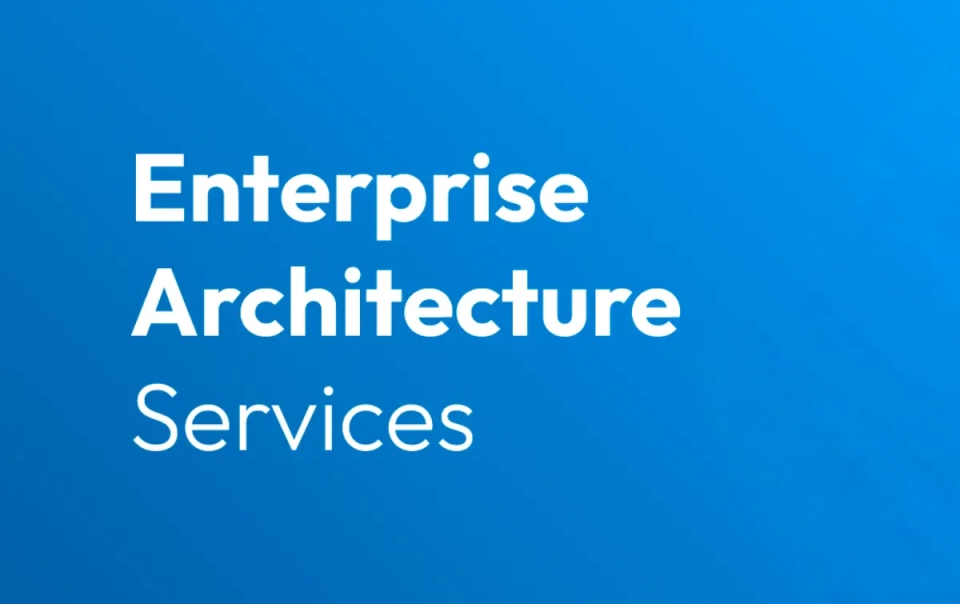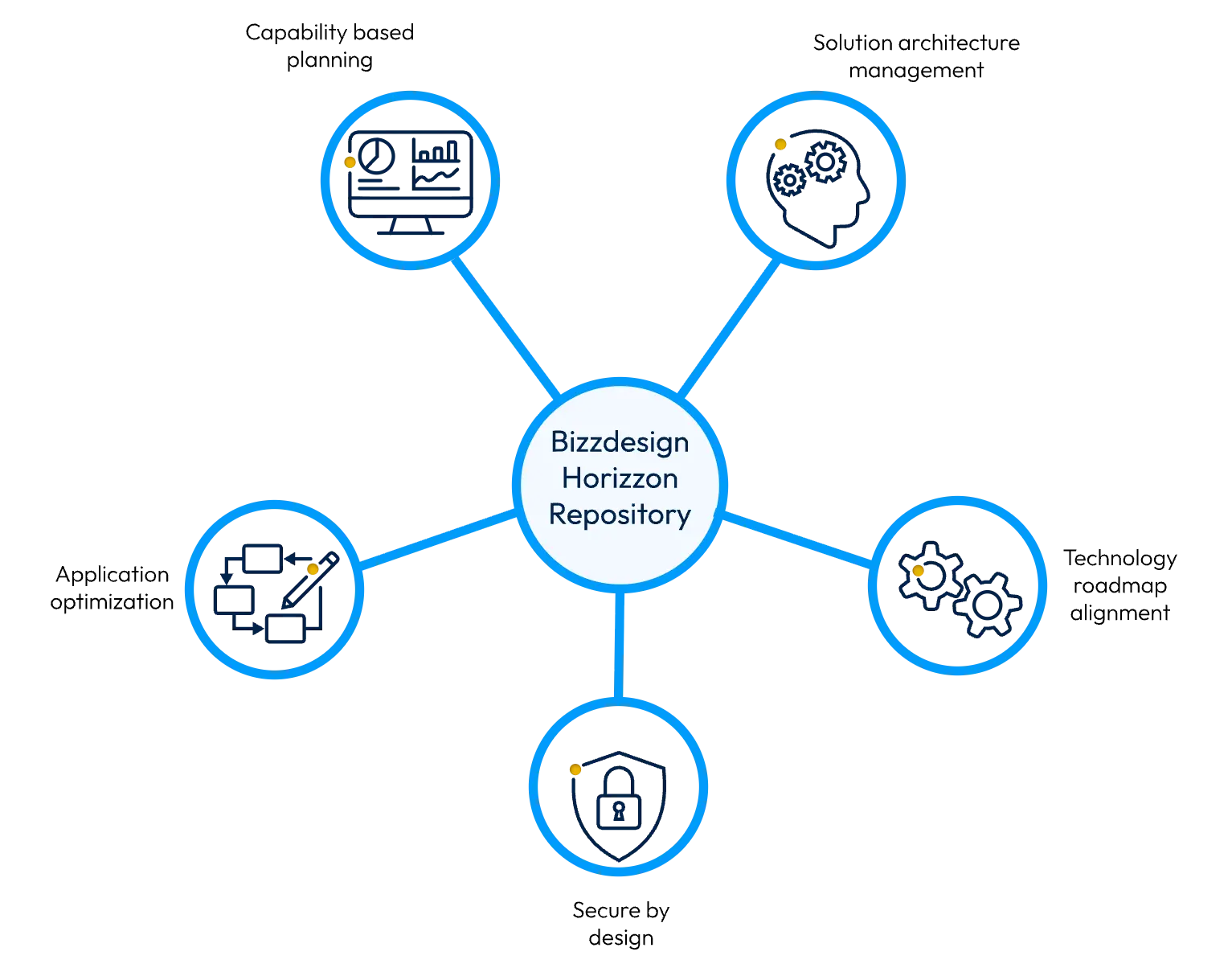Enterprise Architecture Services Explained: Strategy, Planning, and Implementation

Discover why you must incorporate enterprise architecture services as essential building blocks of your enterprise architecture management strategy, highlighting the business value they bring by aligning technology with business goals.
Enterprise architecture services
Enterprise architecture services encompass various activities to manage and optimize an organization’s architecture. They’re essential building blocks in any enterprise architecture strategy, providing a substantial return on investment by enhancing operational efficiency and strategic alignment. The integration of these services leads to a more cohesive digital strategy, creating a robust ‘digital ecosystem’ within the organization.
Key components of enterprise architecture services often include:
- Strategy alignment:Ensuring the organization’s IT systems and infrastructure align with its business goals and strategies.
- Design and planning:Creating a comprehensive design of the enterprise’s architecture, including its business processes, data, applications, and technology infrastructure.
- Analysis and evaluation:Analyzing the current architecture to identify gaps, risks, and opportunities for improvement. Evaluating proposed changes or new systems for fit with the existing architecture.
- Implementation and change management:Helping to implement new systems or changes to the architecture. This could include project management, technical support, and change management to ensure a smooth transition.
- Governance:Providing guidance and oversight to ensure that the architecture remains aligned with business goals and follows agreed standards and principles.
- Training and support:Providing training for employees to understand and work within the defined architecture and ongoing support to resolve any issues.
What are enterprise architecture services?
Enterprise architecture services refer to consulting and technology services that help an organization design, evaluate, and build an effective enterprise architecture. This includes defining, visualizing, and integrating the various business processes, information systems, and infrastructure to support the organization’s strategic objectives.
The term refers to both services developed by the enterprise architecture management team for the organization to consume, as well as specialized consulting, advisory, and implementation services to design, plan and manage the enterprise architecture.
Enterprise architecture services delivered internally
Mature enterprise architecture management teams develop services other than traditional enterprise architecture services. These services align with enterprise architecture capabilities and are developed according to well-defined value streams.
The internal delivery of enterprise architecture services often expands beyond conventional offerings. They are crafted to align with the distinct capabilities of the organization, adhering to well-defined value streams that ensure measurable and repeatable value delivery.
Architecture services in this context focus on delivering best practices and an outcome-driven approach that produces measurable customer value on a regular, repeatable basis. They’re treated like any other customer service, with formal ownership and management.

Source: Bizzdesign Horizzon
Enterprise architecture consulting services
Often, external consulting firms provide enterprise architecture services. These services encompass assessing the current state architecture, definition of target architectures, development of roadmaps, and guidance on architecture-related decisions, enriched with industry benefits of enterprise architecture management.
They involve analyzing business processes, data flows, technology infrastructure, and organizational and enterprise architecture capabilities to ensure alignment with strategic goals.
Why enterprise architecture frameworks are key in enterprise architecture services
Enterprise architecture services are delivered by enterprise architects who leverage frameworks (like TOGAF and tools like ArchiMate) to systematically and holistically configure an organization’s structure and operating model.
Enterprise architecture services leverage frameworks such as TOGAF, and tools like Archimate to systematically and holistically organize an organization’s structure and operating model.
Essentially, the enterprise architecture framework shapes the services, defines their scope and provides a context for understanding them. Frameworks prescribe methods and tools for various enterprise architecture management activities, which translate directly into services provided by architects.
Different enterprise architecture frameworks
ArchiMate:
ArchiMate is a graphical language designed for articulating enterprise architecture, serving as a common language that fosters clear communication and understanding amongst architects. It furnishes a comprehensive suite of concepts and symbols that enable the illustration and examination of the architecture structure, functionality, and relationships. Employing ArchiMate within your enterprise architecture services paves the way for more efficient, intelligible, and actionable architectural designs.
TOGAF:
The Open Group Architecture Framework (TOGAF) is a widely adopted methodology for enterprise architecture development. TOGAF provides a detailed method (the ADM or Architecture Development Method) for developing, maintaining, and using enterprise architecture. This method is typically followed when delivering enterprise architecture services.
BPMN framework:
Business Process Model and Notation (BPMN) is a graphical representation for specifying business processes in a model. While it’s not an enterprise architecture framework like TOGAF, it’s a related tool that can be useful in enterprise architecture services.
A core aspect of enterprise architecture services is understanding the organization’s business processes. BPMN provides a standard set of symbols and notation to visually represent these processes, which can help you understand and analyze how the business operates.
Differentiation: enterprise architecture services vs IT architecture services
While interconnected, Enterprise and IT architecture services serve distinct roles within an organization and offer differing focus scopes.
Enterprise architecture services
Enterprise architecture services adopt a broader, strategic approach, strategic, scrutinizing an organization in its entirety to synchronize technology with business objectives. The scope of these services goes beyond technology, weaving together the various threads that make up an enterprise: business processes, strategy, information systems, and infrastructure.
Enterprise architects work to create a holistic picture of the organization’s structure, aligning it with the business strategy and ensuring that IT systems enable business functions effectively. The key components include strategy alignment, governance, standardization, and integration across the entire organization.
These services often require a wide range of skills, including strategic thinking, comprehensive knowledge of the organization’s business, and an understanding of technology trends and their potential impact.
IT architecture services
IT architects specialize in designing and implementing specific IT systems, like data architecture, network architecture, or software architecture. Their focus is on selecting and managing appropriate technologies, as well as tackling technical challenges associated with the implementation of these systems. IT architects also ensure the performance of technologies and manage IT infrastructure.
While both services are critical and must work in unison to achieve optimal results, it’s important to remember that enterprise architecture’s scope is broader and more strategic. IT architecture focuses more on tactical execution and technical details.
Examples of enterprise architecture services
In this section, we’ll discuss two typical enterprise architecture services and give case studies to showcase their practical implementation.
Digital transformation consulting
Digital transformation consulting services can help your organization unlock new business value through technology by accelerating technology adoption and maximizing its impact.
Business architecture solutions
Business architecture provides a blueprint that bridges the gap between business strategy and execution. Business architecture solutions focus on aligning business strategies, processes, and capabilities. These services can help your organization: define target operating models, optimize business processes, analyze capabilities, and improve decision-making.
Your organizations can make informed decisions and transform business models by understanding the relationships between various business elements, such as customers, products, channels, and operations.
IT strategy and planning
This enterprise architecture service involves aligning IT investments with business objectives, defining technology roadmaps, and ensuring the effective utilization of IT resources. The IT strategy focuses on setting clear goals, establishing priorities, and outlining the path to achieve desired outcomes.
IT planning involves resource allocation, budgeting, and project prioritization. By integrating IT strategy and planning into enterprise architecture services, organizations can ensure that technology initiatives are aligned with business needs, support growth and innovation, and enable the efficient deployment of IT resources.
Technology roadmap development
Technology roadmap development is a crucial component of enterprise architecture services. It entails assessing the current technology landscape, identifying gaps and areas for improvement, and defining a strategic plan for technology adoption and integration. For this, organizations need top enterprise architecture tools.
A technology roadmap visually represents technology initiatives, timelines, and dependencies. It outlines the technology investments’ sequence, estimated costs, and expected benefits.
Summary
By developing a technology roadmap, organizations can ensure that technology decisions are aligned with business objectives, mitigate risks associated with technology adoption, and facilitate informed decision-making regarding IT investments.
Enterprise architecture governance
ensures the effective management and governance of architectural activities. It involves establishing processes, policies, and structures to guide decision-making, enforce compliance, and ensure the relevance and quality of architectural artifacts. Enterprise architecture governance ensures that your team’s architecture initiatives align with organizational strategies, standards, and best practices.
By implementing effective governance practices within enterprise architecture services, your team can maximize the value derived from architectural efforts, minimize risks, and ensure the long-term sustainability of their architecture practices.



